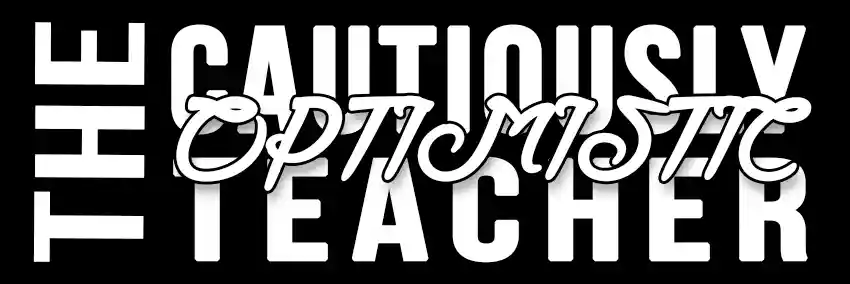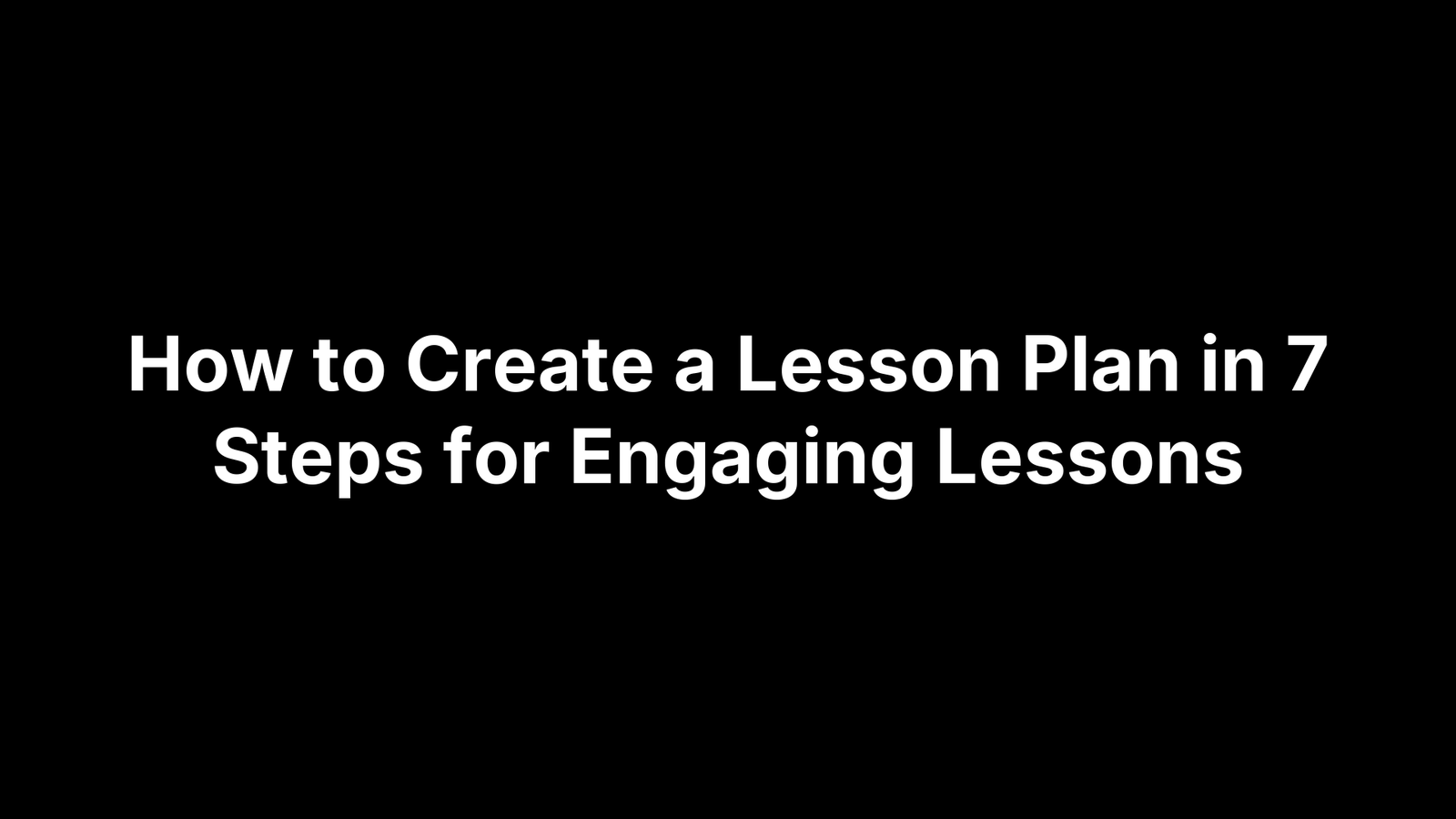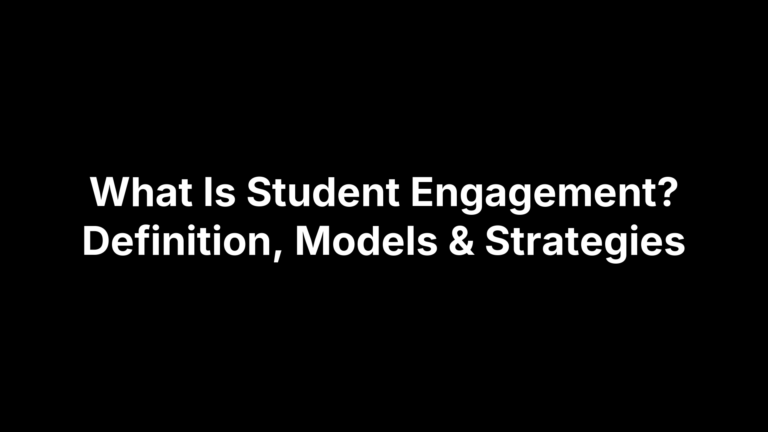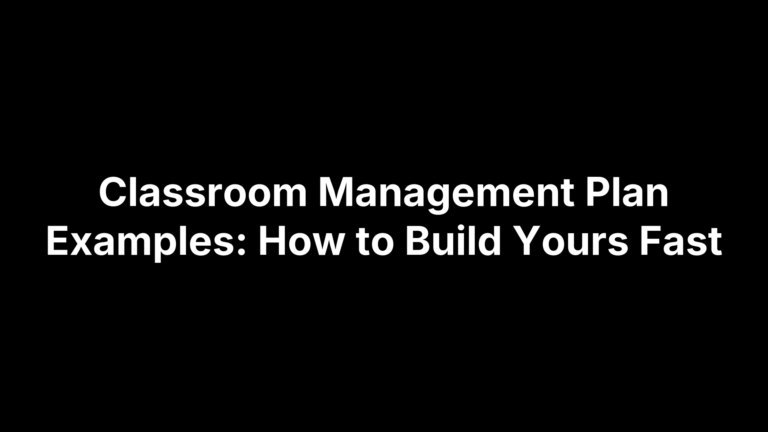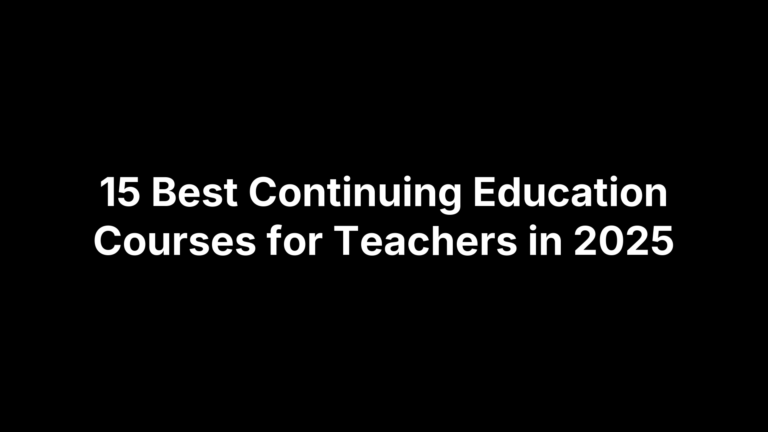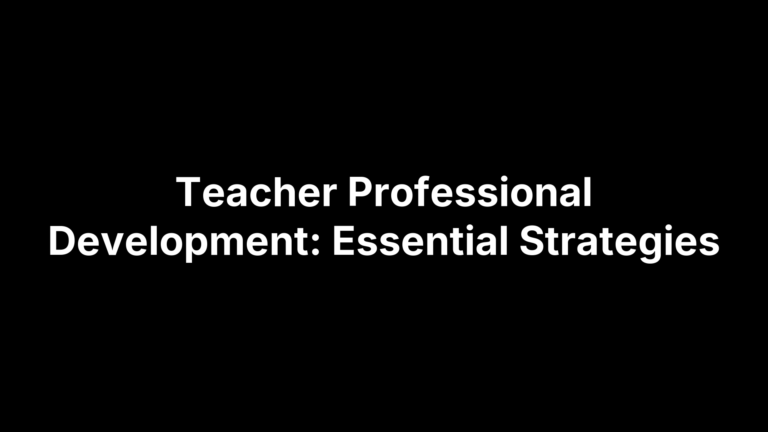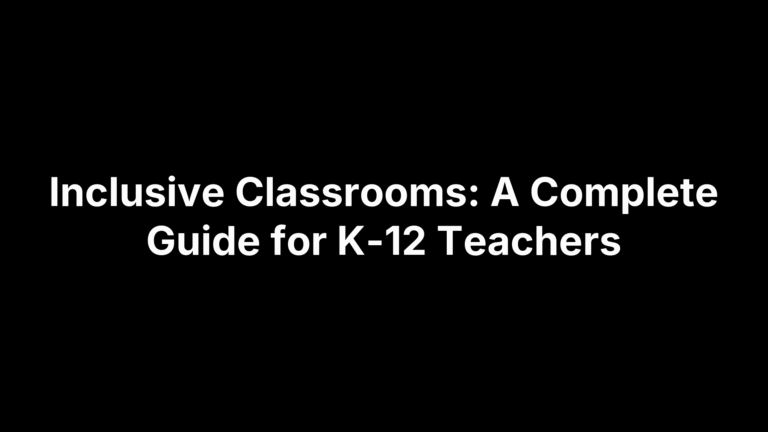How to Create a Lesson Plan That Engages and Assesses Learning
Ever walked out of class feeling the lesson drifted off course even though your slides were polished? That difference between materials and a plan can mean the day’s objectives stay out of reach. A lesson plan is a concise roadmap showing what students will learn, how they will practice it, and which evidence will prove mastery. Follow a clear, repeatable structure—seven steps you’ll read below—and you’ll move from scattered activities to an engaging, assessment-driven experience.
When your planning hits these benchmarks, everything else clicks: pacing stays tight, differentiation feels manageable, and accountability documents write themselves. This guide walks you through defining measurable objectives, knowing your learners, designing spot-on assessments, and building hooks that spark curiosity. You’ll see real examples, templates, and tech shortcuts you can copy straight into tomorrow’s lesson. Ready to trade last-minute scrambling for confident, student-centered instruction? Let’s map it out. By the end, you’ll walk away with a plug-and-play template you can tweak in minutes, not hours.
Step 1: Pinpoint Clear, Measurable Learning Objectives
Think of objectives as the GPS coordinates for your lesson: without them, every turn is a guess. Before you sketch activities or hit “print” on worksheets, decide exactly what students should know or be able to do by the final bell. Tight objectives keep instruction focused, make assessment design a cinch, and ensure every minute moves learners toward standards-aligned mastery.
Why Objectives Are the Cornerstone of Every Lesson
Goals are the big dream (“master persuasive writing”); objectives are the bite-size, observable steps that get students there. Borrowing from Backward Design, you start with the end—then plan backwards. Clear objectives
- streamline resource selection,
- inform differentiation, and
- provide evidence for administrators that you know how to create a lesson plan grounded in standards.
Crafting SMART Objectives Students Can Own
Use the SMART filter: Specific, Measurable, Achievable, Relevant, Time-bound. Swap vague verbs for Bloom-powered action words.
Before → After
- “Understand photosynthesis” → “By the end of class, students will diagram the photosynthesis cycle and label five key components with 90 % accuracy.”
- “Learn figurative language” → “Students will identify and explain two examples of metaphor and simile in the poem ‘Ode.’”
Post objectives in student-friendly language so they can self-monitor progress.
Checking Alignment with Bloom’s Taxonomy and Curricular Standards
Match the cognitive demand of each state or district standard to a Bloom’s level, then choose verbs accordingly.
| Bloom Level | Sample Verbs |
|---|---|
| Remember | list, define |
| Understand | summarize, classify |
| Apply | solve, demonstrate |
| Analyze | compare, organize |
| Evaluate | justify, critique |
| Create | design, compose |
One standard can blossom into multiple objectives: a 5th-grade NGSS standard on ecosystems might yield “describe energy flow” (Understand) and “model a food web” (Create). Check vertical (across grades) and horizontal (across subjects) alignment to keep learning coherent.
Step 2: Know Your Learners and Set Success Criteria
When you’re figuring out how to create a lesson plan that actually lands, start by looking at the people in front of you. Data on prior knowledge, interests, language proficiency, and learning preferences turns a generic outline into a tailored experience. Pair that intel with crystal-clear success criteria and students can track their own growth instead of waiting for the gradebook to speak.
Assess Prior Knowledge, Interests, and Needs
Grab a snapshot before you teach:
- quick pre-tests or entry tickets for readiness
- KWL charts to surface what learners already “Know” and want to learn
- one-minute interest surveys to spark relevance
Record the results in your planner or LMS, then tweak grouping, examples, or pace on the spot. Informal chats and hallway observations count, too—jot them down while they’re fresh.
Define Observable Success Criteria for Mastery
Objectives say what; success criteria show how it looks in practice. Swap “explain clearly” for “use three academic vocabulary words accurately in a two-minute explanation.” Co-create an anchor chart with the class that lists those look-fors; students can point to it mid-task to self-check and peer-coach.
Incorporate Social-Emotional and Language Considerations
Layer in language objectives (“use the past tense to describe events”) for English learners and build SEL moments—team norms for collaboration or a reflection prompt tied to CASEL competencies. Accommodate processing speed with extended think-time, offer visual timers for attention, and provide sensory tools or quiet corners when overstimulation looms. Meeting these needs clears the runway for every student to hit the success criteria you’ve set.
Step 3: Decide How You Will Assess Learning
With the destination set, figure out how you’ll know students actually arrived. Backward design says pick the evidence first, then build activities. Tight assessments keep the lesson honest; they reveal misconceptions early, validate growth, and provide the data administrators ask for. Choose methods that match the objective’s verb and the amount of cognitive lift required.
Choosing Between Formative and Summative Tools
Formative assessments are low-stakes pit stops—exit tickets, digital polls, whiteboard flashes, think-pair-share—that let you redirect in real time. Summative tasks close the lesson: a performance demo, short quiz, or mini-project that proves mastery. Use formative checks every 10–15 minutes for pacing clues; reserve summatives for the final third when practice time has occurred.
Designing Assessments that Map Directly to Objectives
Start a quick table: Objective → Evidence → Success Criteria. If the objective says “analyze propaganda techniques,” the evidence can’t be a multiple-choice recall quiz; it needs an analysis prompt or annotated ad screenshot. Borrow the same Bloom’s verb so alignment is obvious to anyone reviewing your plan. Misaligned assessments waste time and inflate grades without reflecting learning.
Rubrics, Checklists, and Quick Checks: Practical Examples
- Single-point rubric: center column lists ideal criteria (e.g., “Uses three domain-specific terms correctly”); margins capture plus-deltas.
- Checklist: “Hypothesis stated,” “Variables labeled,” “Graph includes units” for a science lab report.
- Quick checks for large classes: thumbs-up/down, color cards, emoji meter in a learning management system. These micro-assessments take under 30 seconds yet give instant clarity on who’s ready to move and who needs reteaching.
Step 4: Hook Students with a Compelling Anticipatory Set
Before the meat of the lesson, give students a taste that makes them lean in. A well-designed hook lasts three to five minutes, links to the objective, and wakes up prior knowledge so new learning sticks.
Purpose and Timing of the Hook
Novelty fires dopamine; emotion boosts recall. Use that brain science in the opening moments—right after the bell, before housekeeping—so the class energy rides straight into instruction instead of drifting toward side chatter.
Proven Strategies to Spark Curiosity (Stories, Questions, Mystery Objects)
- ELA: Read a one-sentence cliffhanger and ask, “What would you do next?”
- Math: Flash a receipt that doesn’t add up and challenge, “Where’s the error?”
- Science: Unveil a sealed bag of wilting leaves—“Why did these die while the others thrived?”
- Social Studies: Display a meme from a past election and ask, “Propaganda or parody?”
Smooth Transitions from Hook to Instruction
Bridge quickly: “The receipt problem you spotted is exactly what our objective—solving multi-step equations—will fix.” Post the agenda, cue your attention signal, and you’ve shifted from curiosity to clear direction without losing momentum.
Step 5: Map the Lesson Sequence and Active Learning Activities
Now that the hook has students leaning forward, sketch the “learning arc” that carries them from modeling to independent application. A clear sequence prevents whiplash, keeps cognitive load manageable, and makes sure every task earns its place. Think of the lesson as a short story: exposition, rising action, climax, and resolution—all driven by active learning so knowledge sticks past tomorrow’s quiz.
Break Down the Gradual Release Model (I Do, We Do, You Do)
I Do (5–7 min)
- Direct teach the key concept with concise visuals or a live demo.
- Narrate your thinking aloud to reveal problem-solving moves.
We Do (8–12 min)
- Guide the class through a worked example, pausing for choral responses or elbow-partner checks.
- Use targeted questions to surface misconceptions immediately.
You Do Together (10–15 min)
- Small-group practice: stations, jigsaws, or peer tutoring.
- Circulate with a mini-whiteboard for on-the-spot reteaching.
You Do Alone (5–10 min)
- Independent exit task aligned to the objective and success criteria.
- Collect for formative data before the next lesson.
Engage Multiple Modalities: Hands-On, Visual, Auditory, Digital
- Pair a mini-lecture with a graphic organizer so note-takers have structure.
- Add a kinesthetic element—sorting cards, gallery walks—to activate muscle memory.
- Embed a 90-second simulation or GIF loop for complex processes.
- Offer voice-to-text or captioned videos for accessibility and Universal Design for Learning compliance.
Manage Time and Pacing with a Block-By-Block Schedule
| Activity | Minutes | Key Resources | Buffer Plan |
|---|---|---|---|
| Hook & Objective | 3 | Meme slide | Skip intro video if time slips |
| I Do | 6 | Doc cam demo | Screen-record for absent students |
| We Do | 10 | Interactive slide deck | Move one example to homework |
| Group Practice | 12 | Task cards, timers | Consolidate to pairs |
| Independent Check | 7 | Exit ticket Google Form | Paper slip backup |
| Closure & Cleanup | 2 | Agenda slide | Omit if bell rings |
Building this micro-timeline into your lesson plan template safeguards pacing, frees mental bandwidth for facilitation, and ensures every learner gets adequate practice before the summative moment.
Step 6: Plan Differentiation, Supports, and Materials
Even the slickest sequence can fall flat if it assumes every learner starts at the same point or accesses information the same way. Building differentiation and supports directly into your plan—not tacked on last minute—keeps engagement high and prevents reteaching marathons later. When you show administrators how to create a lesson plan that anticipates diverse needs, you signal craftsmanship and care.
Adjust Content, Process, Product, and Environment
Use Carol Tomlinson’s four levers to vary challenge without watering anything down:
- Content – Provide condensed readings for emerging readers or enrichment articles for fast-movers.
- Process – Offer choice: watch a three-minute explainer, study a diagram, or join a teacher-led mini-group.
- Product – Let students show mastery through a podcast, infographic, or traditional essay.
- Environment – Create quiet corners, standing desks, or virtual breakout rooms for focus preferences.
Tiered tasks and choice boards make this menu visible so students self-select the stretch that fits.
Scaffold Learning for Diverse Abilities and IEP/504 Needs
Layer supports without lowering the bar:
- Sentence frames or guided notes to organize thinking
- Chunked text with headings for processing speed
- Graphic organizers and manipulatives for abstract ideas
- Assistive tech—text-to-speech, closed captions, color overlays
Check each IEP/504 accommodation and embed it into slides, handouts, or groupings so compliance is automatic, not reactive.
Resource Checklist: Materials, Tech Tools, and Backup Plans
| Item | Purpose | Where to Grab | Plan B |
|---|---|---|---|
| Task cards (30) | Group practice | Copy room bin | Display on doc cam |
| Chromebook cart | Digital quiz | Room 214 | Print paper quiz |
| Graphic organizer | Scaffold analysis | Shared drive | Plain notebook page |
| Timer app | Pacing cues | Teacher iPad | Wall clock + verbal cues |
| Mystery object | Hook | Supply closet | Slide photo |
Print or pin this table to your template and prep items the day before; your future self will thank you when the Wi-Fi blinks or the copier jams.
Step 7: Reflect, Refine, and Record for Next Time
A lesson isn’t finished when the bell rings; reflection is the final, make-or-break move in any strong lesson plan. Looking back while evidence is fresh cements wins, reveals blind spots, and keeps you from reinventing the wheel next quarter. Block five quick minutes after class, grab your notes app, and treat reflection like any other non-negotiable step in how to create a lesson plan.
Post-Lesson Reflection Questions to Ask Yourself
Use a voice memo or sticky note to tackle these prompts before the hallway fills:
- What evidence shows students met (or missed) the objective?
- Where did engagement spike or dip?
- Which misconceptions surfaced, and how will I address them?
- Did timing match the agenda, or were adjustments needed?
Gathering Student Feedback and Evidence of Impact
Model a growth mindset by inviting students into the process:
- 3-2-1 exit slips (3 takeaways, 2 questions, 1 “aha”)
- Emoji meters on your LMS for instant vibe checks
- One-minute Google Forms asking “What helped you learn today?”
Compile trends in a spreadsheet; patterns over several days pinpoint tweaks that matter more than one-off comments.
Saving, Sharing, and Iterating on Your Lesson Plan
Treat each plan as a living doc:
- Adopt a naming convention—
2025-09-08_Photosynthesis_L2_v1—so versions sort chronologically. - Store in a cloud folder shared with your PLC; collective edits beat solo tinkering.
- Highlight changes directly in the file (e.g., ADD stronger hook, CUT slide 7) so next year’s you remembers the “why.”
Over time, this digital archive becomes a ready-made curriculum map and a portfolio of professional growth.
Keep Your Lessons Dynamic and Student-Centered
Lesson plans don’t live in binders—they breathe in real classrooms. Start with laser-focused objectives, ground them in what you know about your learners, and align every assessment, hook, and activity to those aims. Scaffold practice through active, multimodal tasks, differentiate smartly, then circle back with honest reflection. Follow this 7-step loop consistently and you’ll spend less time firefighting and more time celebrating aha-moments.
Remember: the secret sauce isn’t a fancy template; it’s your willingness to tweak, iterate, and co-create with students. Keep listening to their feedback, swapping in fresh hooks, and updating success criteria so instruction never goes stale.
Ready for the next boost? Dive into the time-saving AI tools, unit plans, and templates waiting for you at The Cautiously Optimistic Teacher and make “how to create a lesson plan” the easiest part of your day.
